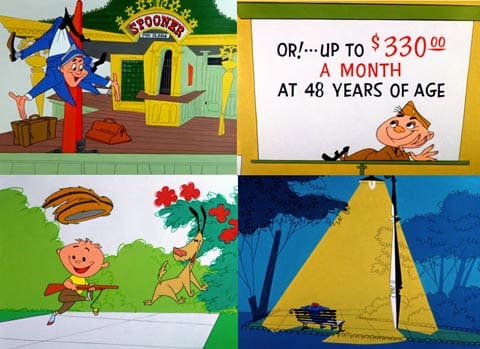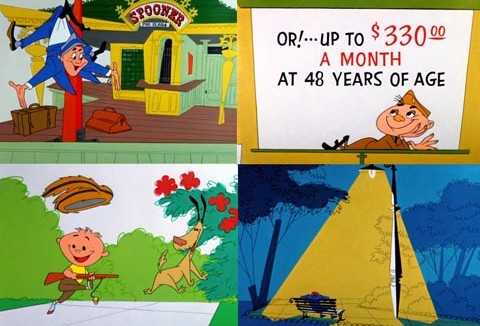

“90 Day Wondering” By Chuck Jones

The post about the 1955 Chuck Jones short A Hitch in Time was well received, so let’s complete the story. Jones made at least two more military propaganda films following that one—90 Day Wondering in 1956 and Drafty, Isn’t It? in 1957.
The gem of the bunch may be 90 Day Wondering. I’d seen some of Maurice Noble’s layout concepts for this short when researching the book Cartoon Modern, but regretfully, hadn’t seen the short. It is an absolutely fantastic example of the ‘cartoon modern’ aesthetic, with an astounding level of craft that is far beyond the needs of the plebeian ideas expressed in the film.
The first minute of the film has an expert piece of temporal and spatial compression. We follow the main character’s ecstatic journey out of the military and back to his hometown while he runs around in a whirlwind a la the Tasmanian Devil. It’s also a great use of animated movement to illustrate the inner emotions of a character.
When the main character is finally revealed to the audience, he has arrived at his hometown of Spooner, which also happens to be Maurice Noble’s birthplace (Spooner Township, Minnesota). Noble is at his peak of layout powers in this short. He plays liberally with exaggeration of shapes in the background, perspective, pattern and color, and thinks nothing of it to key some of the backgrounds in full color while using stark white backdrops for other scenes in the film.
The main character, Ralphie, is designed with more realism than one might expect of a Warner Bros. cartoon, but that is a direct consequence of the cartoon’s purpose, which was first and foremost to convince military personnel to re-enlist. Ralphie’s realistic design also plays a nice contrast to the cartoonier characters Pete and Re-Pete, who play the role of his conscience.
It’s a thrill at this late date to discover new Chuck Jones cartoons from the Fifties. It’s also educational. Looking at Jones films that I’ve never seen allows me to be objective about their quality in a way that I can’t be about the classic Jones shorts that I’ve seen dozens of times.
This trio of military-propaganda shorts that Jones made is phenomenally impressive. Jones’s crew brings a level of expertise and professionalism to the table that is woefully lacking (dare I say, completely absent) in much of today’s cartoon animation. If anything, the films should serve as a reminder that almost any idea or concept can be enhanced by animation if the animation is entrusted to filmmakers who are passionate about the craft of visual storytelling.

.png)